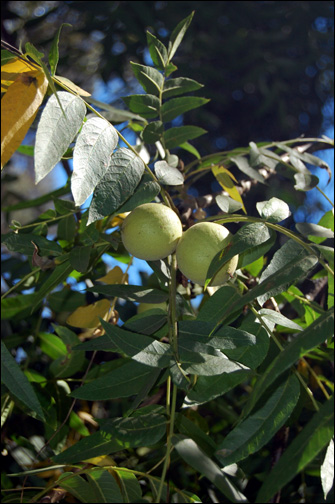
I've always been attracted to ideas that are both simple and surprisingly effective. This easy project is one of those ideas.
A few years back, I read a fascinating article in American Archaeology on prehistoric musical instruments from the American Southwest (Hoover 2005). What really caught my eye was a photo and description of a rattle made from black walnut shells found in the Canyon de Chelly area of northern Arizona. For all practical purposes it resembles the well-known deer hoove rattle, but with walnut shells substituted for the hooves. Why didn't I think of this??

Most of us in the United States probably live in an area with access to black walnut trees, which have been widely planted as an ornamental as well as for production of the delicious nut meats and beautiful hardwood. Living in the San Francisco Bay Area, I'm not far from the town of Walnut Creek, whose namesake is one of the few native stands of black walnut in California. Any and all species of black walnuts will work just fine for this project.
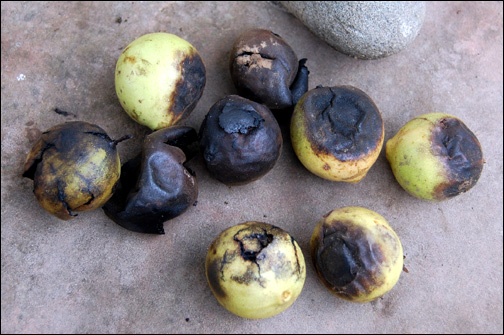
The raw materials, the nuts themselves, are easily collected in the fall when multitudes collect at the base of the trees. I recommend either using older fallen nuts (the husks will be black), or drying the green nuts before processing.
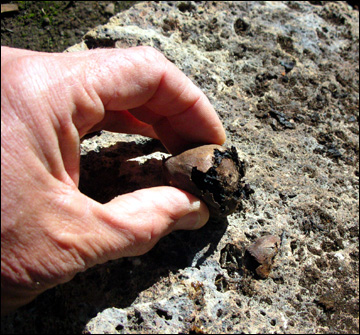
Using either a knife blade or sharp stone flake, you next scrape away all of the husk material. This can also be accomplished by abrading against a flat grinding stone or metate. NOTE: You might want to wear gloves when de-husking, as the husks produce a long-lasting stain on the hands.

After the husked nuts are dried, the top of the nut needs to be ground or sanded off, revealing the inner chambers and nut meats. This can be accomplished either abo style by rubbing against a flat abrading stone or by using sandpaper, if time is a factor.
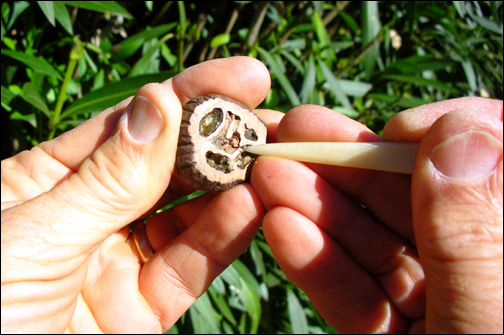
Using a small sharp tool such as a bone awl, carefully pick away and remover the inner nut meats. Save some of this material to rub on the outside of the shell to produce a nice natural oil finish, and save the rest for your cookie recipes!
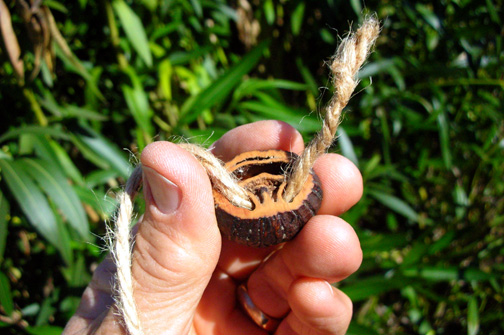
My replica was made using jute cordage, but any native hand-twisted cordage such as dogbane, milkweed or nettle fiber will work fine. Cut enough lengths for each nut to be used (I used nine for mine, based upon the example in the photo I was working from), and string each length (five to six feet) in and out of the inner structure of each nut to secure it. The protruding cordage is then gathered together, doubled back, and wrapped with more cordage to produce the handle.
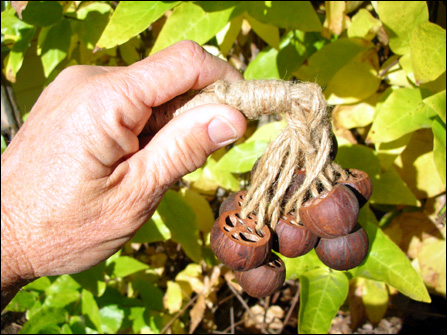
I think you'll find that the resulting rattle has a pleasing, mellow sound that will lend itself nicely to your next aboriginal musical event - enjoy!
References
Hoover, S.
2005 Making Prehistoric Music. American Archaeology 8(4):12-19.
E-mail your comments to "Ken Peek" at kspeek123@att.net
We hope the information on the PrimitiveWays website is both instructional and enjoyable. Understand that no warranty or guarantee is included. We expect adults to act responsibly and children to be supervised by a responsible adult. If you use the information on this site to create your own projects or if you try techniques described on PrimitiveWays, behave in accordance with applicable laws, and think about the sustainability of natural resources. Using tools or techniques described on PrimitiveWays can be dangerous with exposure to heavy, sharp or pointed objects, fire, stone tools and hazards present in outdoor settings. Without proper care and caution, or if done incorrectly, there is a risk of property damage, personal injury or even death. So, be advised: Anyone using any information provided on the PrimitiveWays website assumes responsibility for using proper care and caution to protect property, the life, health and safety of himself or herself and all others. He or she expressly assumes all risk of harm or damage to all persons or property proximately caused by the use of this information.
© PrimitiveWays 2013